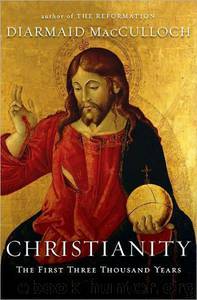Christianity: The First 3000 Years by Diarmaid MacCulloch

Author:Diarmaid MacCulloch
Language: eng
Format: mobi
Tags: Non-Fiction, Judaism, Church history, General, Religion, Rome, Christian Church, Christianity - History - General, Christianity, Religion - Church History, Christian Theology, History
ISBN: 9780670021260
Publisher: Viking/Penguin Group (USA)
Published: 2009-01-01T00:00:00+00:00
17
A House Divided (1517-1660)
A DOOR IN WITTENBERG
Two incidents stick in the popular consciousness from Martin Luther's career: first, that he nailed some theses to a door in Wittenberg, and second, that he came through a spiritual crisis to new faith while sitting on a latrine - his 'Tower Experience' or Turmerlebnis. The first incident probably did happen, and maybe on 31 October 1517, although the original door is not there to enlighten us, having been burned by French troops in 1760.1 Its replacement is a nineteenth-century confection, part of a lavish and romantic Gothic Revival reconstruction of the dynastic chapel of the Wettin family, beside their former palace. This 'Castle Church' now rather uncomfortably tries to kill three birds with one stone: to celebrate the medieval Holy Roman Empire, the Protestant Reformers whose work helped to tear the empire apart, and the nineteenth-century Hohenzollern dynasty who paid for the new work, and who were concurrently busy constructing a new German Empire (see pp. 837-8). Since the Hohenzollern were ancient and bitter rivals of the Wettin, the rebuilding had a certain piquancy. In an additional level of irony, a distinctly unreformed or under-reformed Hohenzollern prelate had triggered Luther's protest in the first place, as we will see.
The reconstructed door is a focus for Lutheran pilgrimage on Reformation Day, 31 October, the only day of the year on which the place now enterprisingly styling itself 'Lutherstadt Wittenberg' is crowded with visitors. Luther is about the one flourishing industry left in this small east German town in Saxony. By contrast, Luther's basement latrine in Wittenberg has not as yet developed much of a following after its recent rediscovery by archaeologists (the tower above it in his former monastery and family home having inexplicably been demolished by thoughtless Lutherans in 1840). Its continuing neglect is just as well, as its role in the Reformation story is myth, and based on a misunderstanding of the grammar in Luther's Latin reminiscence of his Turmerlebnis. We can still enjoy these and less dubious souvenirs of Wittenberg's glory years in the Reformation because the town was one of the few in Germany to be spared bombing in the Second World War. That exemption was a tribute to the worldwide impact of a monk-lecturer's spiritual turmoil in what in 1517 was one of Europe's newest universities.
The university owed its existence to the then head of the Wettin dynasty, Friedrich of Saxony, a strong-minded and creative ruler, by hereditary right one of seven electors, who chose a new Holy Roman Emperor when required (the imperial title had never become hereditary). That honour gave Friedrich a good deal of influence on the Habsburg dynasty, who since the early fifteenth century had normally provided one of their number as the next emperor, but who could never be certain that the electors would allow this to continue. Without the Elector Friedrich's support (puzzling in its consistency - he did not know Martin Luther well and never approved of his religious revolution), it is
Download
This site does not store any files on its server. We only index and link to content provided by other sites. Please contact the content providers to delete copyright contents if any and email us, we'll remove relevant links or contents immediately.
| Buddhism | Christianity |
| Ethnic & Tribal | General |
| Hinduism | Islam |
| Judaism | New Age, Mythology & Occult |
| Religion, Politics & State |
Cecilia; Or, Memoirs of an Heiress — Volume 1 by Fanny Burney(31341)
Cecilia; Or, Memoirs of an Heiress — Volume 3 by Fanny Burney(30938)
Cecilia; Or, Memoirs of an Heiress — Volume 2 by Fanny Burney(30894)
The Secret History by Donna Tartt(16642)
Sapiens: A Brief History of Humankind by Yuval Noah Harari(13067)
Leonardo da Vinci by Walter Isaacson(11912)
The Radium Girls by Kate Moore(10914)
Sapiens by Yuval Noah Harari(4545)
The Wind in My Hair by Masih Alinejad(4427)
How Democracies Die by Steven Levitsky & Daniel Ziblatt(4407)
Homo Deus: A Brief History of Tomorrow by Yuval Noah Harari(4286)
Endurance: Shackleton's Incredible Voyage by Alfred Lansing(3851)
The Silk Roads by Peter Frankopan(3767)
Man's Search for Meaning by Viktor Frankl(3644)
Millionaire: The Philanderer, Gambler, and Duelist Who Invented Modern Finance by Janet Gleeson(3573)
The Rape of Nanking by Iris Chang(3519)
Hitler in Los Angeles by Steven J. Ross(3442)
The Motorcycle Diaries by Ernesto Che Guevara(3340)
Joan of Arc by Mary Gordon(3262)
